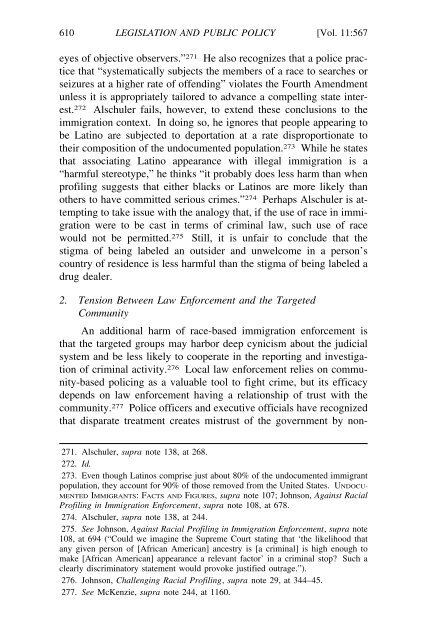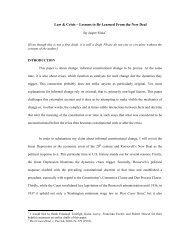updating brignoni-ponce - New York University School of Law
updating brignoni-ponce - New York University School of Law
updating brignoni-ponce - New York University School of Law
You also want an ePaper? Increase the reach of your titles
YUMPU automatically turns print PDFs into web optimized ePapers that Google loves.
610 LEGISLATION AND PUBLIC POLICY [Vol. 11:567<br />
eyes <strong>of</strong> objective observers.” 271 He also recognizes that a police practice<br />
that “systematically subjects the members <strong>of</strong> a race to searches or<br />
seizures at a higher rate <strong>of</strong> <strong>of</strong>fending” violates the Fourth Amendment<br />
unless it is appropriately tailored to advance a compelling state interest.<br />
272 Alschuler fails, however, to extend these conclusions to the<br />
immigration context. In doing so, he ignores that people appearing to<br />
be Latino are subjected to deportation at a rate disproportionate to<br />
their composition <strong>of</strong> the undocumented population. 273 While he states<br />
that associating Latino appearance with illegal immigration is a<br />
“harmful stereotype,” he thinks “it probably does less harm than when<br />
pr<strong>of</strong>iling suggests that either blacks or Latinos are more likely than<br />
others to have committed serious crimes.” 274 Perhaps Alschuler is attempting<br />
to take issue with the analogy that, if the use <strong>of</strong> race in immigration<br />
were to be cast in terms <strong>of</strong> criminal law, such use <strong>of</strong> race<br />
would not be permitted. 275 Still, it is unfair to conclude that the<br />
stigma <strong>of</strong> being labeled an outsider and unwelcome in a person’s<br />
country <strong>of</strong> residence is less harmful than the stigma <strong>of</strong> being labeled a<br />
drug dealer.<br />
2. Tension Between <strong>Law</strong> Enforcement and the Targeted<br />
Community<br />
An additional harm <strong>of</strong> race-based immigration enforcement is<br />
that the targeted groups may harbor deep cynicism about the judicial<br />
system and be less likely to cooperate in the reporting and investigation<br />
<strong>of</strong> criminal activity. 276 Local law enforcement relies on community-based<br />
policing as a valuable tool to fight crime, but its efficacy<br />
depends on law enforcement having a relationship <strong>of</strong> trust with the<br />
community. 277 Police <strong>of</strong>ficers and executive <strong>of</strong>ficials have recognized<br />
that disparate treatment creates mistrust <strong>of</strong> the government by non-<br />
271. Alschuler, supra note 138, at 268. R<br />
272. Id.<br />
273. Even though Latinos comprise just about 80% <strong>of</strong> the undocumented immigrant<br />
population, they account for 90% <strong>of</strong> those removed from the United States. UNDOCU-<br />
MENTED IMMIGRANTS: FACTS AND FIGURES, supra note 107; Johnson, Against Racial R<br />
Pr<strong>of</strong>iling in Immigration Enforcement, supra note 108, at 678. R<br />
274. Alschuler, supra note 138, at 244. R<br />
275. See Johnson, Against Racial Pr<strong>of</strong>iling in Immigration Enforcement, supra note<br />
108, at 694 (“Could we imagine the Supreme Court stating that ‘the likelihood that R<br />
any given person <strong>of</strong> [African American] ancestry is [a criminal] is high enough to<br />
make [African American] appearance a relevant factor’ in a criminal stop? Such a<br />
clearly discriminatory statement would provoke justified outrage.”).<br />
276. Johnson, Challenging Racial Pr<strong>of</strong>iling, supra note 29, at 344–45. R<br />
277. See McKenzie, supra note 244, at 1160. R
















